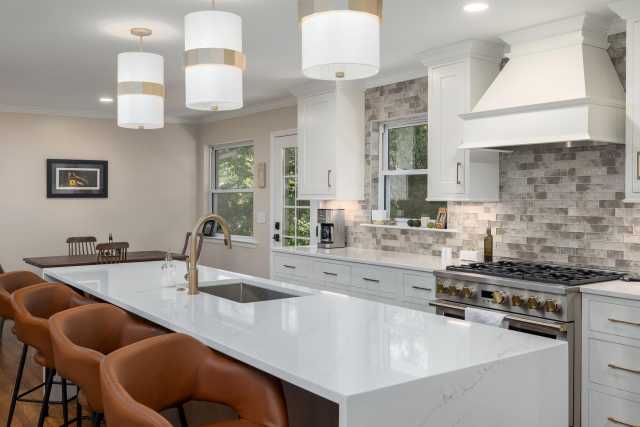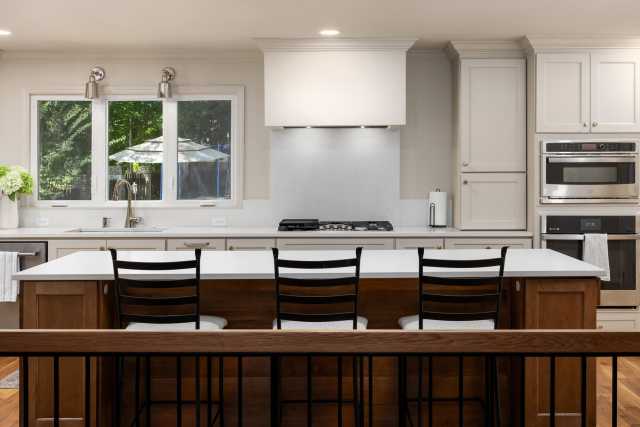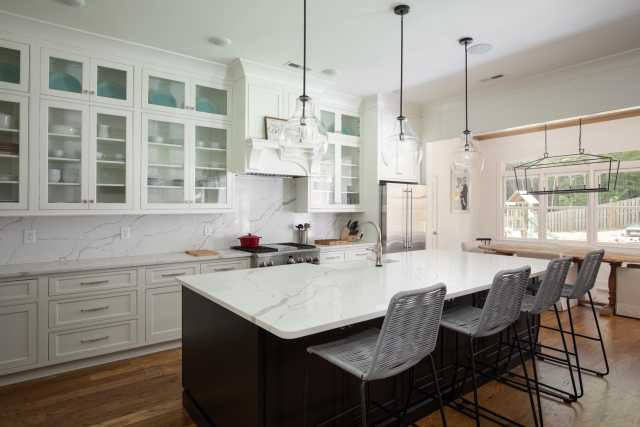The Culinary Stage: A Comprehensive Guide to Designing the Perfect Residential Chef's Kitchen - Part 2

The Engine Room - A Connoisseur's Guide to Professional-Grade Appliances
The heart of any chef's kitchen is its arsenal of appliances. These are not mere conveniences but high-performance tools that enable precision, power, and versatility. The selection process is critical, as the choice of a single major appliance can have a cascading effect on the kitchen's infrastructure, including its ventilation, gas, and electrical systems. This decision must be made early in the design phase, in close consultation with designers and contractors, to ensure the home can support the demands of professional-grade power.
The Heart of the Heat: Selecting Your Cooking Arsenal
The cooking appliances are the functional and aesthetic anchor of the kitchen. The choice between a range, cooktop, and wall ovens, as well as the fuel type, will define the cooking experience.
- Pro-Style Ranges: These commanding appliances are a hallmark of the chef's kitchen, distinguished by their robust construction, heavy cast-iron grates, and powerful performance. They typically range in size from a standard 30 inches to an expansive 60 inches, with larger models offering more burners and features like built-in griddles or grills. The signature feature is the high-BTU (British Thermal Unit) burners, which can produce up to 25,000 BTUs of intense heat for rapid boiling and perfect searing, far exceeding the sub-10,000 BTU output of standard residential ranges. Equally important is the ability to maintain a delicate, true simmer for sauces and melting. Top-tier brands like
Wolf, Viking, BlueStar, Thermador, and Miele each offer a distinct philosophy. Wolf is renowned for its iconic red knobs, dual-stacked burners that provide both power and precision, and superior temperature control. BlueStar is favored by those who want raw power and customization, offering open burners that deliver intense heat and a palette of over 1,000 colors and finishes. Thermador is known for its innovative star-shaped burners, which provide more even heat distribution across the bottom of a pan. - Fuel Type: Gas, Dual-Fuel, or Induction?
- All-Gas Ranges are prized by many chefs for the responsiveness and visual feedback of a live flame.
- Dual-Fuel Ranges offer what many consider the best of both worlds: a gas cooktop for precise, immediate heat control, paired with an electric convection oven, which provides the dry, even heat ideal for baking and roasting.
- Induction Cooktops represent the pinnacle of modern cooking technology. They use magnetic fields to heat the pan directly, resulting in incredible power, speed, and efficiency. They are also considered safer, as the cooktop surface itself does not get hot, and they are easier to clean. A significant advantage for residential design is that induction cooking produces less ambient heat and fewer emissions, potentially reducing the demands on the ventilation system.
- The Combi-Steam Oven: For the serious home baker and health-conscious cook, the combination steam-convection oven, or "combi-steam," is a revolutionary tool. By introducing steam into the cooking process, these ovens create a moist environment that is perfect for baking crusty artisan breads, roasting juicy meats, and perfectly reheating leftovers without drying them out. Top manufacturers like
Wolf, Miele, Gaggenau, and Thermador offer sophisticated models with features like plumbed-in water lines (eliminating the need to refill a water tank), climate sensors that automatically adjust humidity levels, and precise sous-vide cooking modes. - Multiple Ovens & Warming Drawers: A true chef's kitchen must be able to execute multiple dishes at different temperatures simultaneously. This makes a minimum of two high-end ovens—often a main convection oven and a secondary combi-steam oven—a necessity. To manage the complex timing of a multi-course meal, warming drawers are indispensable. These discreet, built-in drawers hold finished dishes at the perfect serving temperature without overcooking them, allowing the chef to focus on the final elements before plating.
A crucial consideration is the aesthetic integration of these powerful machines. There is a fundamental design choice to be made between the "professional" look of exposed, industrial stainless steel and the "luxury residential" approach of integrated, paneled appliances. Brands like Viking and BlueStar celebrate the bold, utilitarian look of the machine itself. Conversely, brands like Sub-Zero and Miele specialize in creating appliances that can be fitted with custom panels to match the surrounding cabinetry, allowing them to disappear into a seamless, unified design. This choice between an "industrial workshop" and a "bespoke culinary studio" is a core aesthetic decision that should align with the overall architecture and style of the home.
Brand | Core Philosophy / Strengths | Signature Features | Ideal User Profile |
Wolf | Precision & Control | Dual-stacked sealed burners; iconic red knobs; superior convection technology | The meticulous technician who values consistent, repeatable results and precise temperature control. |
BlueStar | Raw Power & Customization | High-BTU open burners (up to 25,000 BTUs); over 1,000 color/trim options; commercial-grade build | The high-heat enthusiast who wants restaurant-level searing power and a personalized aesthetic statement. |
Viking | Professional Heritage & Robustness | Wide range of sizes and configurations; powerful performance; durable construction | The serious home chef who wants a durable, powerful, and iconic centerpiece with a professional pedigree. |
Thermador | Innovation & Efficiency | Patented star-shaped burners for even heating; features like the ExtraLow simmer | The tech-savvy cook who appreciates innovative engineering designed to improve cooking efficiency and evenness. |
Miele | Sleek Design & Advanced Technology | European styling; advanced features like Moisture Plus (steam injection); user-friendly interfaces | The modern cook who values sleek, integrated design and cutting-edge features for versatile cooking. |
La Cornue | Artistry & Luxury | Hand-crafted French ranges; vaulted ovens (gas and electric); unique, elegant design | The connoisseur for whom the range is as much a piece of art as a cooking appliance; budget is a secondary concern. |
Cold Storage Command: The Art of Professional-Grade Refrigeration
A chef's kitchen requires refrigeration that goes beyond standard residential capacity. Large, professional-quality refrigerators and freezers are essential for storing the volume and variety of fresh ingredients needed for ambitious cooking. Premier brands like Sub-Zero are synonymous with this category, but high-end lines from Bosch, Frigidaire, and Samsung also offer compelling features.Key features to look for include a large internal capacity, dual compressors that keep the moist air of the refrigerator separate from the dry air of the freezer, and advanced air purification systems that scrub the air of ethylene gas, bacteria, and odors to extend the life of fresh produce. For a seamless, high-end look, panel-ready models that can be fitted with custom cabinetry fronts are the preferred choice, allowing the refrigeration to blend invisibly into the kitchen's design.Configuration is also a critical choice. While French door models offer the convenience of wide, full-width shelves for items like platters and sheet pans, their bottom-drawer freezers can be inefficient for organizing and accessing frozen goods. For maximum capacity and organization, many chefs opt for separate, column-style refrigerator and freezer units. This allows for a fully customized setup and provides the greatest amount of dedicated storage for both fresh and frozen ingredients.
The Unseen Essential: Specifying a Powerful and Quiet Ventilation System
Perhaps the most critical and often underestimated component of a chef's kitchen is the ventilation system. The high heat, grease, and steam produced by a pro-style range will quickly overwhelm a standard microwave vent or low-power hood. A powerful, high-capacity range hood that vents to the exterior of the home is not a luxury; it is an absolute necessity for maintaining air quality and protecting cabinetry from grease and moisture damage. The power of a range hood is measured in Cubic Feet per Minute (CFM). The general rule for sizing is to provide 1 CFM of ventilation for every 100 BTUs of the range's total output. For example, a 6-burner range with a total output of 90,000 BTUs requires a hood rated for at least 900 CFM. Brands like Proline offer hoods with power ratings of 1200 CFM and beyond to handle the most demanding cooking. In an open-plan home, however, power creates a new problem: noise. A 1200 CFM motor operating at full speed can make conversation impossible. The solution for the serious cook who also wants to entertain is to invest in a quiet ventilation system. This can be achieved with ultra-quiet models that use advanced baffling and sound-dampening materials, or, for the ultimate in silent performance, a remote blower system. This setup places the noisy motor in a remote location, such as the attic or on an exterior wall, connected to the hood via ductwork. The result is exceptionally powerful ventilation with almost no noise in the kitchen itself, a crucial investment for a social chef's kitchen.
The Cleanup and Prep Crew: Sinks, Faucets, and Dishwashers
- Sinks: The mantra for a chef's kitchen sink is "multiple and deep." The space should feature at least two sinks: a large, single-basin cleanup sink for washing oversized pots and pans, and a secondary prep sink, often located in the island, for washing produce and other prep tasks. Deep, single-basin designs are favored over divided sinks because they can easily accommodate large items. Stainless steel is the classic material choice for its durability and professional aesthetic. Some large sinks even feature double faucets, allowing two people to work simultaneously.
- Faucets: A high-arc, pull-down faucet with a powerful spray function is essential for its reach and versatility in cleaning and prep. A highly coveted feature is the
pot filler, a wall-mounted, articulated faucet located directly over the range. This practical luxury eliminates the strain and potential spills of carrying heavy, water-filled stockpots from the sink to the stove, a small detail that makes a significant difference in workflow. - Dishwashers: To manage the high volume of dishes generated during complex meal preparation and entertaining, a chef's kitchen should be equipped with at least two high-performance dishwashers. This prevents dirty dishes from piling up in the sink, which can halt workflow and create clutter. Brands like
Cove (the sister brand to Sub-Zero and Wolf), Bosch, and Miele are known for their quiet operation, flexible loading options, and superior cleaning performance, making them ideal choices for a high-end kitchen.





